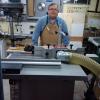So I just got my A3-41 and after an hour or so I got the outfeed dialed in perfectly with the segmented cutter heads.
Then I moved on to the infeed and there is a major problem, at least to me with my limited experience. So basically the infeed is perfectly flat across its length near the fence, but on the operator's side there is a large gully. It starts about 3 or so inches from the cutter head and ends about 6 inches or so from the beginning of the infeed. This gully is about 13 thou or so. When I check around the middle of the infeed between the operator's side and the fence this gully is about half this much.
I talked to Felder support and they're very helpful, but at the end of the day none of the adjustments I can make to try to achieve coplanar will remove this gully. So when I get the infeed first few inches from the cutterhead section coplanar to the outfeed that's great, except that gully is always there. I'm going to call them tomorrow to discuss further, but I'm pretty frustrated at this point and would love some advice on whether this is a big deal or not.
They said that their tolerances running diagonal across the infeed are 13 thou. Which first off seems like a lot, but secondly how does this matter if half of my table (the operator's side) is not even close to flat. Won't this cause all kinds of issues? I'm waiting on a new dust hose before running some boards through and it'll be here on Friday, but again any help would be greatly appreciated.




 Reply With Quote
Reply With Quote



